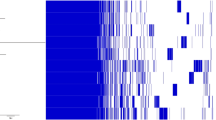Abstract
Lactobacillus plantarum J23 was previously characterized as a bacteriocin-producer-strain when it was cocultured with other lactic acid bacteria. In this work, the genetic organization of the pln locus in the J23 strain was studied and compared with those of previously described L. plantarum C11, WCFS1 and NC8 strains. A new organization of the plantaricin locus was detected in the J23 strain. The sequenced fragment (20,266 bp) comprised plnJLR, plnMNOP, plnEFI, plnGHSTUVWXY, and plNC8IF-plNC8HK-plnD operons, as well as a new region that includes three new orfs (GenBank accession number DQ323671). When the J23 pln gene sequences were compared with those included in the GenBank database, the identity of the putative encoded proteins was in the range 67.1–100%. The regulatory system and the repertoire of putative bacteriocins of the J23 pln locus presented important differences with respect to the ones of C11, WCFS1 and NC8, such as the absence of plnK and the presence of a larger plnJ gene than the previously described for the other L. plantarum strains. The pln locus in L. plantarum strains seems to be a mosaic-like structure with different modules and reorganizations that presents highly conserved regions related to transport and bacteriocin maturation and variable regions related to regulation and bacteriocin production.




Similar content being viewed by others
References
Anderssen EL, Diep DB, Nes IF, Eijsink VGH, Nissen-Meyer J (1998) Antagonistic activity of Lactobacillus plantarum C11: two new two-peptide bacteriocins, plantaricins EF and JK, and the induction factor plantaricin A. Appl Environ Microbiol 64:2269–2272
Cotter PD, Hill C, Ross RP (2005) Bacteriocins: developing innate immunity for food. Nat Rev Microbiol 3:777–788
Diep DB, Håvarstein LS, Nes IF (1995) A bacteriocin-like peptide induces bacteriocin synthesis in Lactobacillus plantarum C11. Mol Microbiol 18:631–639
Diep DB, Håvarstein LS, Nes IF (1996) Characterization of the locus responsible for the bacteriocin production in Lactobacillus plantarum C11. J Bacteriol 178:4472–4483
Diep DB, Myhre R, Johnsborg O, Aakra Å, Nes IF (2003) Inducible bacteriocin production in Lactobacillus is regulated by differential expression of the pln operons and by two antagonizing response regulators, the activity of which is enhanced upon phosphorylation. Mol Microbiol 47:483–494
Hauge HH, Mantzilas D, Eijsink VGH, Nissen-Meyer J (1999) Membrane-mimicking entities induce structuring of the two-peptide bacteriocins plantaricin E/F and plantaricin J/K. J Bacteriol 181:740–747
Håvarstein LS, Diep DB, Nes IF (1995) A family of bacteriocin ABC transporters carry out proteolytic processing of their substrates concomitant with export. Mol Microbiol 16: 229–240
Holo H, Jeknic Z, Daeschel M, Stevanovic S, Nes IF (2001) Plantaricin W from Lactobacillus plantarum belongs to a new family of two-peptide lantibiotics. Microbiology 147:643–651
Kleerebezem M, Boekhorst J, van Kranenburg R, Molenaar D, Kuipers OP, Leer R, Tarchini R, Peters SA, Sandbrink HM, Fiers MWEJ, Stiekema W, Lankhorst RMK, Bron PA, Hoffer SM, Groot MNN, Kerkhoven R, de Vries M, Ursing B, de Vos WM, Siezen RJ (2003) Complete genome sequence of Lactobacillus plantarum WCFS1. Proc Natl Acad Sci USA 100:1990–1995
Maldonado A, Ruiz-Barba JL, Floriano B, Jiménez-Díaz R (2002) The locus responsible for production of plantaricin S, a class IIb bacteriocin produced by Lactobacillus plantarum LPCO10, is widely distributed among wild-type Lactobacillus plantarum strains isolated from olive fermentations. Int J Food Microbiol 77:117–124
Maldonado A, Ruiz-Barba JL, Jiménez-Díaz R (2003) Purification and genetic characterization of plantaricin NC8, a novel coculture-inducible two-peptide bacteriocin from Lactobacillus plantarum NC8. Appl Environ Microbiol 69:383-389
Maldonado A, Jiménez-Díaz R, Ruiz-Barba JL (2004) Induction of plantaricin production in Lactobacillus plantarum NC8 after coculture with specific gram-positive bacteria is mediated by an autoinduction mechanism. J Bacteriol 186:1556–1564
Michiels J, Dirix G, Vanderleyden J, Xi C (2001) Processing and export of peptide pheromones and bacteriocins in Gram-negative bacteria. Trends Microbiol 9:164–168
Molenaar D, Bringel F, Achuren FH, de Vos WM, Siwezen RJ, Kleerebezem M (2005) Exploring Lactobacillus plantarum genome diversity by using microarrays. J Bacteriol 187:4848–4852
Moll GN, van den Akker E, Hauge HH, Nissen-Meyer J, Nes IF, Konings WN, Driessen AJM (1999) Complementary and overlapping selectivity of the two-peptide bacteriocins plantaricin EF and JK. J Bacteriol 181:4848–4852
Pei J, Grishin NV (2001) Type II CAAX prenyl endopeptidases belong to a novel superfamily of putative membrane-bound metalloproteases. Trends Biochem Sci 26:275–277
Remiger A, Eijsink VGH, Ehrmann MA, Sletten K, Nes IF, Vogel RF (1999) Purification and partial amino acid sequence of plantaricin 1.25α and 1.25β, two bacteriocins produced by Lactobacillus plantarum TMW1.25. J Appl Microbiol 86:1053–1058
Risøen PA, Johnsborg O, Diep DB, Hamoen L, Venema G, Nes IF (2001) Regulation of bacteriocin production in Lactobacillus plantarum depends on a conserved promoter arrangement with consensus binding sequence. Mol Genet Genomics 265:198–206
Rojo-Bezares B, Sáenz Y, Navarro L, Zarazaga M, Ruiz-Larrea F, Torres C (2007) Coculture-inducible bacteriocin activity of Lactobacillus plantarum strain J23 isolated from grape must. Food Microbiol 24:482–491
van Belkum MJ, Worobo RW, Stiles ME (1997) Double-glycine-type leader peptides direct secretion of bacteriocins by ABC transporters: colicin V secretion in Lactococcus lactis. Mol Microbiol 23:1293–1301
Acknowledgments
This work was supported in part by a grant (AGL2002-2293) from the Ministry of Education and Science of Spain and FEDER of the European Community and from the Gobierno de La Rioja (ACPI2003/01). B. Rojo-Bezares was supported by a doctorate grant from the Spanish Ministry of Education and Science (BI-UR-03/16586.840) and Y. Sáenz is a contractual technician supported by grant PTA-2003-02-00002 from the Spanish Ministry of Education and Science.
Author information
Authors and Affiliations
Corresponding author
Additional information
Communicated by Erko Stackebrandt.
Rights and permissions
About this article
Cite this article
Rojo-Bezares, B., Sáenz, Y., Navarro, L. et al. Characterization of a new organization of the plantaricin locus in the inducible bacteriocin-producing Lactobacillus plantarum J23 of grape must origin. Arch Microbiol 189, 491–499 (2008). https://doi.org/10.1007/s00203-007-0342-6
Received:
Revised:
Accepted:
Published:
Issue Date:
DOI: https://doi.org/10.1007/s00203-007-0342-6




